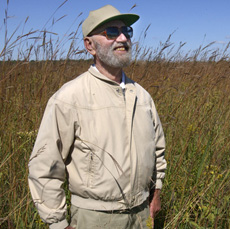Robert Betz, prairie visionary

Robert Betz, founder and leader of Fermilab's Prairie Restoration Project from 1973 to 2007, died on Thursday, April 5.
Robert Betz, whose inspiration sparked the restoration of Fermilab's acres of prairie, died April 5 after battling cancer. He was 84. His devotion shaped the landscape of Fermilab, a groundbreaking model of prairie restoration. Betz began the restoration project in 1973; today, almost 20 percent of the lab's grounds have been restored native grasses and wildflowers.
"I'll just miss Bob the man, his friendship and his willingness to share what he knew," said Mike Becker, Roads and Grounds manager. "His life's work will continue at Fermilab. The prairie will continue to grow just has he wanted it to."
After a 1959 trip to the Sante Fe Prairie in Hodgkins, Ill., Betz caught prairie fever. He started visiting old cemeteries and railroad tracks in the Midwest, looking for patches of prairie as models to bring prairie lands back to their original glory. "He was tenacious," Becker said. Betz loved to tell a story about one of his former students, who found a prairie plant that was extremely rare in Illinois. Excited to tell Betz about his find, he began walking out of the prairie area, but, looking down in the rocks, he saw a pencil marked Northeastern Illinois University. Betz had already been there.
A former biology and biochemistry professor at Northeastern Illinois University, who was sometimes called Professor Prairie, Betz was a natural, cheerful teacher. "He'd tell you something one week, and then ask you the next week to make sure you had caught on," Becker said. "But he was always good-natured about it. He never took anything too seriously."
Martin Valenzuela of Roads and Grounds used to go to lunch with Betz after working in the prairie. Betz always wanted to go to Burger King so he could mix the sodas. "He was like a kid," Valenzuela said. "Laughing out loud -- that's how I'll remember him." Valenzuela added: "The lesson I learned from him is his motivation to teach me about the prairie. That's something respectful. How wonderful."
Bob Lootens of Roads and Grounds, who began working with Betz nearly 30 years ago, still hears Betz's voice in his head, teaching him the Latin names of plants. "If you had the patience to listen, he had the patience to teach," Lootens said. Lootens recounted a time when he had messed up a detail during a prairie burn. Betz's response: "Don't worry. In a hundred years, no one will know the difference." Said Lootens: "That's not true of Bob Betz's work. His legacy will stay with the lab forever."
Read more
--Kate Raiford
|